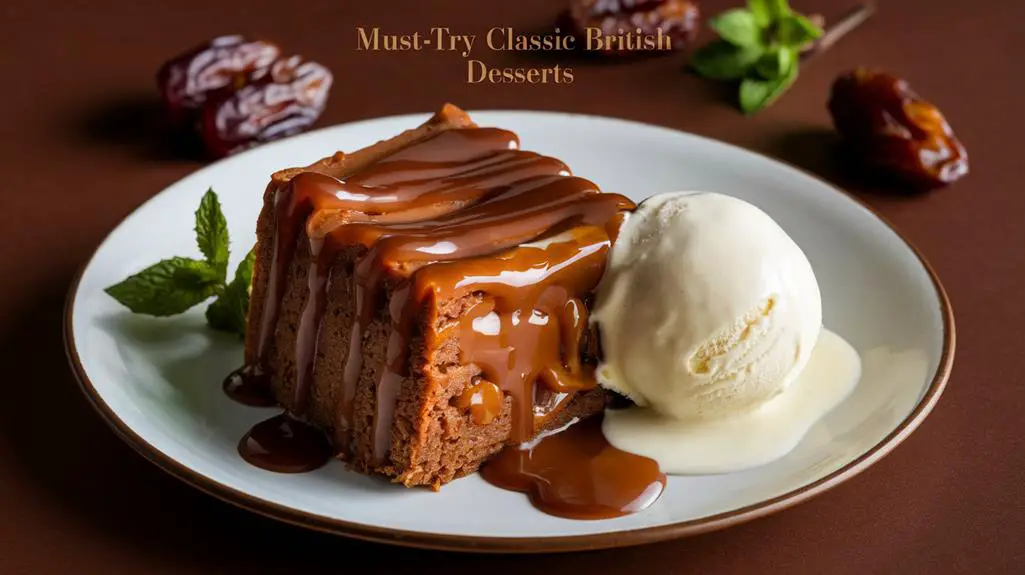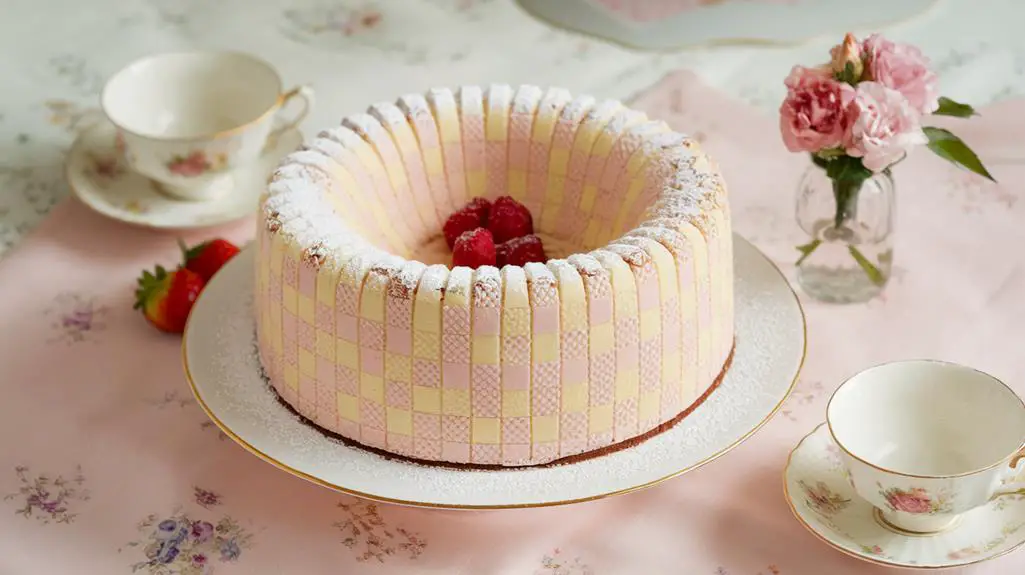When one considers the rich tapestry of British culinary traditions, classic desserts stand out as essential experiences. From the indulgent Sticky Toffee Pudding to the layered elegance of Old English Trifle, these treats reflect a deep-rooted history and a comforting nostalgia. Each dessert tells a story, whether it's the warmth of Spotted Dick with custard or the festive allure of Mincemeat Pie. As one uncovers these ten must-try delights, they'll discover not just flavors, but also a connection to Britain's cultural heritage. Yet, which dessert truly deserves the spotlight?
Need cookware for your meal? Toolbox, a Pear to Pear rental marketplace, might be worth a look.
Quick Takeaways
- Scottish Shortbread: A rich, crumbly treat made with butter, sugar, and flour, perfect for tea time or festive occasions.
- Old English Trifle: A layered dessert featuring sponge cake, custard, jelly, and whipped cream, known for its vibrant flavors and visual appeal.
- Sticky Toffee Pudding: Moist sponge cake with dates, drizzled in luscious toffee sauce, often served warm with ice cream or custard.
- Spotted Dick: A comforting suet pudding filled with currants, traditionally served warm with creamy custard, embodying classic British cuisine.
- Treacle Tart: A sticky dessert made with treacle, breadcrumbs, and lemon juice, often enjoyed warm with clotted cream, and famous as Harry Potter's favorite.
Scottish Shortbread
What makes Scottish shortbread such a beloved treat across the United Kingdom? This delightful creation, which dates back to the Middle Ages, became especially popular thanks to Mary Queen of Scots. Its significance in Scotland's culinary history is undeniable.
The traditional recipe features a simple yet luxurious blend of butter, sugar, and flour, yielding a rich, crumbly texture that melts in the mouth. To achieve the perfect consistency, it's crucial to chill the dough before baking. This step guarantees that every bite delivers that classic, melt-in-your-mouth quality.
Scottish shortbread is often enjoyed as part of festive occasions or paired with a comforting cup of tea, making it a staple among British desserts.
The versatility of shortbread enhances its appeal; it can take on various shapes and sizes, from fingers to rounds, and even intricate designs. Each variation offers a unique experience, inviting people to indulge in these sweet treats.
Whether served at a gathering or gifted to friends, Scottish shortbread remains a cherished delight that captures the essence of Scotland while delighting taste buds across the UK.
Old English Trifle
Scottish shortbread's rich, buttery texture sets the stage for another classic British indulgence: the Old English Trifle. This traditional dessert has delighted taste buds for over 300 years and is a vibrant celebration of flavors and textures.
Typically layered with luscious sponge cake, creamy custard, colorful jelly, and light whipped cream, the trifle showcases fresh berries that add a burst of sweetness, making it a visual feast as well as a culinary delight.
Often prepared in a large glass bowl, the trifle becomes a stunning centerpiece at festive gatherings, particularly during Christmas and summer celebrations. Its popularity surged in the Victorian era, and variations abound, with some recipes incorporating sherry or Madeira wine for an adult twist.
For those who wish to enjoy this British classic without the hassle of making it from scratch, supermarkets like Sainsbury's offer convenient ready-made versions.
Whether serving it at a family gathering or a special occasion, the Old English Trifle is sure to impress guests and satisfy cravings for delightful British desserts.
Sticky Toffee Pudding

Sticky Toffee Pudding, a beloved British classic, combines moist sponge cake with rich dates, creating a dessert that warms the heart and delights the palate.
Originating from the scenic Lake District, this indulgent treat has secured its place in British pubs and restaurants, enchanting dessert lovers far and wide.
The magic of Sticky Toffee Pudding lies in its luscious toffee sauce, generously drizzled over the warm sponge, enhancing its comforting sweetness.
Often served with a scoop of creamy vanilla ice cream or a pour of velvety custard, this dessert transforms any meal into a special occasion.
Homemade desserts like Sticky Toffee Pudding evoke nostalgia, making it a favorite choice for gatherings and celebrations.
Whether enjoyed as a comforting end to a hearty meal or as a sweet indulgence on a quiet evening, its rich flavor profile and satisfying texture guarantee it remains a quintessential comfort food in British cuisine.
For those looking to share a taste of tradition, preparing Sticky Toffee Pudding at home is a rewarding experience that will surely impress family and friends alike.
Spotted Dick
Spotted Dick stands as a delightful tribute to traditional British dessert culture, enchanting the taste buds with its unique blend of suet and plump currants. This classic pudding, dotted with fruit that gives it a charming "spotted" appearance, has its roots in 19th-century England. The name may even derive from the word "dough," reflecting its substantial texture.
Served warm, Spotted Dick often comes accompanied by a generous pour of creamy custard, enhancing its comforting and nostalgic appeal. As diners slice into the rich, dense pudding, they're greeted with a satisfying heft, making it a beloved choice among families and friends during gatherings.
Despite its somewhat humorous name, Spotted Dick symbolizes the heart of traditional English cuisine, cherished for its simplicity and warmth. It's a dish that invites sharing, sparking conversations and laughter alike.
Whether enjoyed at a festive occasion or a cozy family meal, this iconic dessert remains a must-try for anyone wishing to indulge in classic British flavors. So, when hosting a dinner, consider serving Spotted Dick to offer guests a taste of history and a sweet ending to their meal.
Mincemeat Pie

Mincemeat pie, a cornerstone of British festive traditions, has transformed from its meaty origins to a delightful, meat-free dessert packed with apples, raisins, and warming spices.
Its rich flavor profile combines the sweetness of dried fruit with the tartness of fresh apples, creating a perfect balance that's especially inviting during the holiday season.
Often served warm with a generous dollop of cream or custard, this pie embodies the spirit of celebration and nostalgia, making it a beloved treat at Christmas gatherings.
Historical Origins and Evolution
The evolution of mincemeat pie reflects centuries of culinary adaptation and cultural significance in British cuisine. Originating in the Middle Ages, this beloved dessert began as a mixture of preserved meat, fruits, and spices, showcasing the era's preservation techniques.
As time passed, the recipe transformed, gradually excluding meat and embracing a blend of sweet and tart fruits. Today's mincemeat pie mainly features apples, raisins, and an aromatic mix of warming spices like cinnamon and nutmeg.
Traditionally, mincemeat pie is enjoyed during the holiday season, but its comforting appeal has made it a year-round favorite. Each slice offers a taste of nostalgia, inviting memories of family gatherings and festive celebrations.
The classic flavor profile harmonizes the sweetness of fruits with the warmth of spices, resulting in a rich, indulgent dessert that captivates the senses.
Served warm or at room temperature, mincemeat pie pairs beautifully with cream or custard, enhancing its delightful essence.
For those looking to share a piece of British culinary heritage, this pie not only satisfies cravings but also brings people together in celebration of tradition and comfort.
Flavor Profile and Ingredients
With a delightful blend of flavors, mincemeat pie captivates the palate through its rich filling of apples, raisins, and currants, all harmonized by the warming spices of cinnamon and nutmeg.
This classic dessert boasts a sweet and spiced flavor profile, providing a comforting experience with every bite.
Modern versions of mincemeat pie have evolved from their medieval origins, becoming meat-free and focusing on high-quality, seasonal ingredients that enhance the pie's depth of flavor and texture.
The combination of tender apples and plump raisins creates a luscious filling, while the currants add a slight tartness, perfectly balanced by the aromatic spices.
Typically served warm or at room temperature, mincemeat pie offers a cozy indulgence, making it a beloved choice during festive celebrations.
Although it's popularly enjoyed year-round, its close association with Christmas guarantees that this dessert remains a staple in British households.
For those looking to impress guests or treat loved ones, mincemeat pie's unique flavor profile and rich history make it a must-try classic that warms the heart and satisfies the sweet tooth.
Seasonal and Festive Enjoyment
What could be more comforting during the chilly winter months than indulging in a slice of mincemeat pie? This beloved dessert, traditionally enjoyed during the holiday season, has transformed over the centuries from its Medieval origins of containing preserved meat to a delightful meat-free filling crafted from apples, raisins, and a medley of spices.
The classic flavor profile of mincemeat pie exudes warmth, with inviting notes of apple and cinnamon, making it a perfect treat for winter festivities.
While mincemeat pie is most commonly associated with Christmas celebrations, its appeal stretches throughout the year, finding a place at many family gatherings across the United Kingdom.
Often served warm, this pie becomes an irresistible centerpiece, especially when accompanied by a dollop of cream or custard, elevating its indulgence even further.
Its rich history and festive connotations guarantee that mincemeat pie remains a cherished staple of British culinary tradition.
For those looking to create a memorable experience for their guests, serving mincemeat pie will surely bring warmth and joy to any occasion, celebrating the essence of the season with each delectable bite.
Jammy Dodgers
Jammy Dodgers capture the essence of British nostalgia with their charming sandwich-style design and delightful fruit-filled center.
These iconic UK treats feature a tender butter base that melts in your mouth, perfectly complementing the sweet jam filling. Typically, raspberry or strawberry flavors take center stage, bringing a burst of fruity sweetness with every bite.
Constructed with two biscuit halves, these delightful cookies encase a generous layer of jam, often cut into whimsical heart or circular shapes. Their presentation is enhanced with a light dusting of confectioners' sugar, adding a touch of elegance that makes them irresistible.
Jammy Dodgers are more than just a snack; they're a cherished dessert enjoyed by both children and adults alike across the UK. Their nostalgic appeal makes them a beloved staple in British homes and bakeries, often evoking memories of childhood treats and family gatherings.
When serving Jammy Dodgers, consider pairing them with a cup of tea or coffee for a delightful afternoon experience.
With their cake-like texture and sponge-like softness, these cookies offer a comforting taste of tradition that everyone will love.
Battenberg Cake

Following the delightful experience of Jammy Dodgers, another beloved British dessert takes center stage: Battenberg Cake. This elegant treat features a unique checkered pattern made from two shades of almond-flavored sponge cake, filled with luscious jam.
It's a showstopper at any gathering, particularly since it gained popularity after the wedding of Queen Victoria's granddaughter in 1884, showcasing the royal culinary influence.
Here are three reasons why Battenberg Cake is a must-try:
- Visual Appeal: The cake's striking checkered design, visible upon slicing, makes it a centerpiece for any occasion.
- Delightful Flavors: The combination of almond, jam, and marzipan creates a harmonious balance of sweetness and texture.
- Baker's Pride: The precise cutting and layering required to create this cake highlight the skill and attention to detail of the baker.
Traditionally coated in marzipan, Battenberg Cake offers a smooth finish that's as inviting as it's delicious.
Commonly served at British celebrations and tea parties, this dessert is sure to impress guests and elevate any gathering.
Madeira Cake
Madeira Cake stands as a timeless staple in British baking, celebrated for its rich texture and delightful simplicity. Named after the fortified Madeira wine traditionally served alongside it, this classic dessert boasts a dense, moist consistency reminiscent of pound cake. The cake's charm lies in its understated elegance, often enhanced by a hint of lemon zest that introduces a revitalizing twist to each bite.
Perfect for afternoon tea, Madeira Cake is versatile enough for both casual gatherings and more formal occasions. Its straightforward recipe makes it an ideal choice for bakers of all levels, allowing anyone to create a delicious treat to share with friends and family.
Whether served plain, dusted with icing sugar, or accompanied by a dollop of cream, this cake never fails to impress.
Moreover, Madeira Cake pairs beautifully with liqueurs, making it a delightful ending to any meal. As guests savor the cake's rich flavors, they'll appreciate the thoughtfulness behind this timeless British dessert.
With its enduring popularity, Madeira Cake remains a cherished addition to any dessert table, inviting everyone to indulge in its classic appeal.
Treacle Tart

Treacle tart, a delightful blend of treacle, breadcrumbs, and a hint of lemon juice, boasts a sticky texture that's hard to resist.
With roots tracing back to the 19th century, this dessert not only holds a special place in British cuisine but also evokes a sense of nostalgia for many.
As it evolves through various interpretations, treacle tart continues to charm dessert lovers across the UK.
Ingredients and Preparation
A delightful slice of treacle tart showcases a golden shortcrust pastry that cradles a rich filling of treacle, breadcrumbs, and a splash of lemon juice. This classic British dessert is a perfect blend of sweetness and acidity, making it a favorite among many.
To prepare this indulgent treat, one needs to gather a few key ingredients:
- Shortcrust Pastry: A buttery base that provides a crisp and flaky texture.
- Treacle: A sweet syrup, similar to molasses, which gives the tart its signature flavor.
- Breadcrumbs: These add a comforting texture, soaking up the treacle's sweetness.
The preparation involves rolling out the pastry and lining a tart tin before pouring in the treacle mixture. Baked until the filling is set and the pastry turns golden brown, the result is a delightful contrast of textures.
To elevate the experience, treacle tart is often served warm, accompanied by a generous dollop of clotted cream. This pairing not only enhances the dessert's sweetness but also brings a luxurious creaminess to each bite.
It's a nostalgic dish, perfect for family gatherings and celebrations.
Historical Significance and Variations
Rich in tradition, Treacle Tart has woven itself into the fabric of British culinary history since at least the 19th century. This beloved dessert features a sweet filling made from treacle, breadcrumbs, and a splash of lemon juice, creating a unique sticky and sweet flavor profile that delights the palate.
Its historical significance is underscored by mentions in classic literature, particularly the works of Charles Dickens, where it often served as a symbol of comfort and home.
Treacle Tart's fame has surged, especially among younger generations, thanks to its status as Harry Potter's favorite dessert. This connection hasn't only revitalized interest in the dish but also introduced it to a whole new audience enthusiastic to experience a slice of literary magic.
Traditionally served warm with clotted cream or custard, Treacle Tart evokes nostalgia, drawing diners into the rich tapestry of British culinary heritage.
Variations of this classic dessert can be found across the UK, with some bakers experimenting with additional flavors or alternative crusts. However, the essence of Treacle Tart remains the same, reflecting the historical practice of utilizing local ingredients to create cherished treats.
Bread and Butter Pudding
There's something undeniably comforting about Bread and Butter Pudding, a beloved staple in British cuisine. This traditional dessert layers buttered bread with dried fruit, soaking it in a rich custard mixture before baking to perfection. Its warm, nostalgic appeal is enhanced by flavors like vanilla and nutmeg, making it an irresistible treat.
Here are three reasons to indulge in this classic dessert:
- Resourceful Cooking: Bread and Butter Pudding often utilizes day-old bread, showcasing the British knack for reducing waste while creating something delicious.
- Historical Charm: With recipes dating back to the 17th century, this dessert carries a rich history, making it a timeless favorite in homes across the UK.
- Versatile Pairing: Typically served warm, it's delightful on its own but truly shines when accompanied by creamy custard or a scoop of ice cream.
This indulgent experience invites everyone to relish a slice, bringing warmth and joy to gatherings.
Whether enjoyed on a chilly evening or at a festive feast, Bread and Butter Pudding remains a cherished dessert that continues to captivate hearts and taste buds alike.
Common Questions
What Is the Most Famous British Dessert?
When it comes to the most famous British dessert, many would argue that Sticky Toffee Pudding takes the crown.
This decadent treat features a moist sponge cake infused with dates, generously drenched in a luscious toffee sauce.
Often served warm alongside vanilla ice cream or custard, it creates a delightful contrast of textures and flavors.
People can't resist its rich, comforting appeal, making it a must-have for any dessert lover's table.
What Is the Most Popular Desert in the Uk?
In the domain of desserts, Sticky Toffee Pudding reigns supreme, enchanting taste buds like no other.
This indulgent treat features a moist sponge cake drenched in a rich toffee sauce, making it a favorite across the UK.
Eton Mess and Bread and Butter Pudding also vie for attention, but Sticky Toffee Pudding's warm, comforting flavors create an irresistible allure.
It's a dessert that's sure to leave guests clamoring for more.
What Is the National Dessert of the Uk?
The national dessert of the UK is Sticky Toffee Pudding.
This delightful treat features a moist sponge cake made with dates, generously drizzled with rich toffee sauce.
Found on many dessert menus in pubs and restaurants, it's traditionally served warm, often paired with creamy vanilla ice cream or custard.
Originating from the scenic Lake District, Sticky Toffee Pudding embodies British culinary culture, celebrated for its comforting and indulgent qualities.
Which Pudding Is Typically British and It Is Not Sweet?
When it comes to typically British puddings that aren't sweet, Spotted Dick stands out.
This traditional dish blends suet and currants, creating a hearty, dense texture that's perfect for colder days. Served warm, it's often accompanied by custard, enhancing its comforting appeal.
Dating back to the 19th century, Spotted Dick showcases Britain's culinary ingenuity, utilizing simple ingredients to create a nostalgic experience that warms both the heart and the soul.
Wrapping Up
In the delightful domain of British desserts, each sweet treat tells a story steeped in tradition and nostalgia. From the rich, sticky embrace of Sticky Toffee Pudding to the whimsical layers of Old English Trifle, these desserts invite everyone to indulge. Whether it's the comforting warmth of a Spotted Dick or the festive cheer of Mincemeat Pie, sampling these classic delights is like taking a delicious journey through Britain's culinary history. Don't miss out on this sweet adventure!
